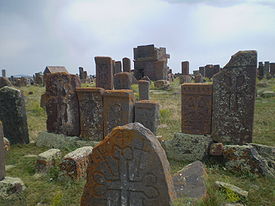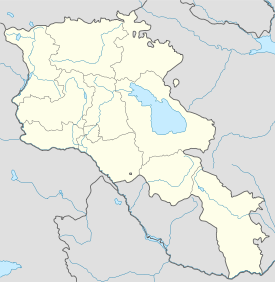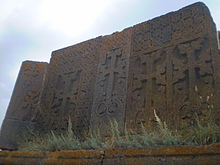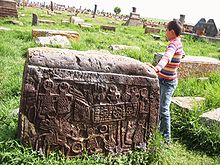- Noraduz cemetery
-
Noratus
Նորատուս
Noratus khachkars and chapelDetails Year established 10th century Country  Armenia
ArmeniaLocation Noratus, Gegharkunik Province Noratus cemetery or Noraduz cemetery (Armenian: Նորատուսի գերեզմանատուն) is a medieval cemetery with a large number of early khachkars located in the village of Noratus, Gegharkunik marz near Gavar and Lake Sevan, 90 km north of Yerevan.[1] The cemetery has the largest cluster of khachkars in the republic of Armenia.[2] It is currently the largest surviving cemetery with khachkars following the destruction of the khachkars in Old Julfa, Nakhichevan by the government of Azerbaijan.[3][4][5][6]
Contents
Khachkars
The oldest khachkars in the cemetery date back to the late 10th century.[1] During the revival of the khachkar tradition in the 16-17th centuries many khachkars were built under the yoke of the Safavid Empire when oriental influences seeped into Armenian art. Three master carvers from this period carved khachkars in Noraduz, the most notable of whom was Kiram Kazmogh (1551-1610), his contemporaries were Arakel and Meliset.[7] The cemetery is spread over a seven hectare field containing almost a thousand khachkars each of them depicting unique ornamentation.[1] The majority of the khachkars are covered by moss and lichen. Several tombstones in the cemetery depict carved scenes of weddings and farm life. Adjacent to the old cemetery a new modern cemetery has been built separated by a long fence. Nearby the cemetery in the village there is the Holy Virgin church built in the ninth century. One of the khachkars from the cemetery was donated to the British Museum in 1978 by Catholicos Vazgen I.[8] The front face of the rectangular khachkar has a leaved-cross with two smaller crosses below that are framed with trefoil and bunches of grapes projecting from either side. An inscription on the left side seeks god's mercy for a certain Aputayli.[8]
Folklore
A popular folktale associated with the cemetery concerns the invading army of Tamerlane. According to one story the villagers placed helmets on top of the khachkars and leaned swords against them. From a distance the khachkars looked like armed soldiers holding a defensive position as a result of which Tamerlane’s army retreated.[1]
In another popular story, the 19th century monk named Ter Karapet Hovhanesi-Hovakimyan, from a monastery near the village, conducted burial services at Noraduz; in order to avoid the two-hour round trip from the cemetery to the monastery he built himself a small cell in Noraduz.[9] When he was 90 years old, he asked his brother monks to bury him alive. His last words were: "I do not fear death. I would like you to not be afraid also. Never fear anything, but God alone. Let anyone who has fear come to me. Pour water at the burial stone, drink the water, wash your face, chest, arms and legs. Then break the vessel that contained the water. Fear will then abandon you." To this day people come to the monk's grave to perform this ritual, leaving broken pieces of glass scattered all about.[9]
Gallery
Notes
- ^ a b c d Hakobyan, Julia (2003-09-12). "Life in the Monuments of Death: A visit to the cemetery village, Noraduz". ArmeniaNow.com. http://www.armenianow.com/archive/2004/2003/september12/features/lifeinmon/index.htm. Retrieved 2007-10-10.[dead link]
- ^ Kouymjian, Dr. Dickran. "Arts of Armenia". Sculpture. Armenian Studies Program, CSU, Fresno. http://armenianstudies.csufresno.edu/arts_of_armenia/sculptures.htm. Retrieved 2007-10-10.
- ^ "World Watches In Silence As Azerbaijan Wipes Out Armenian Culture". The Art Newspaper. 2006-05-25. http://www.theartnewspaper.com/article01.asp?id=281. Retrieved 2007-10-10.
- ^ "Tragedy on the Araxes". Archaeology. 2006-06-30. http://www.archaeology.org/online/features/djulfa/index.html. Retrieved 2006-06-30.
- ^ "Azerbaijan: Famous Medieval Cemetery Vanishes". Institute for War and Peace Reporting. 2006-04-19. http://iwpr.net/index.php?p=crs&s=f&o=261191&apc_state=henpcrs261191. Retrieved 2007-10-10.
- ^ European Parliament On Destruction of Cultural Heritage
- ^ Ney, Richard L. (2005). "Who Made Khachkars?". The Gift of Stone. TourArmenia. http://www.tacentral.com/khachkars/khachkar7.html. Retrieved 2007-10-11.
- ^ a b Parry, 397
- ^ a b (Russian) "Armenia. Stone crosses.". Vokrug Sveta. 2003-12-28. http://www.vokrugsveta.ru/tv/vs/archives/?item_id=390. Retrieved 2007-10-10.
References
- Parry, Ken (July 20, 2007). The Blackwell Companion to Eastern Christianity (1 ed.). Wiley-Blackwell. pp. 528. ISBN 0631234233.
Further reading
- Mnatsakanyan, S. Kh (1987). Sevan: Hayravank, Noraduz, Batikian, Hatsarat, Masruts Anapat, Shoghagavank, Vanevan, Kotavank, Makenotsats (1 ed.). OEMME. pp. 87. ISBN 8885822010.
- Marsden, Philip (1995). The Crossing Place: A Journey Among the Armenians. Kodansha International. pp. 248. ISBN 1568360525.
 Historical Armenian monasteries and churches
Historical Armenian monasteries and churches 
Republic of Armenia Aghjots Vank · Akhtala · Arakelots · Arates · Areni · Artavazik · Aruchavank · Askipari · Avan · Ayrk · Bardzrakash · Bgheno-Noravank · Byurakan · Chiki Vank · Daputs · Ddmashen · Deghdznuti · Dvin · Etchmiadzin Cathedral · Gayane · Geghard · Gharghavank · Gladzor · Gndevank · Goshavank · Haghartsin · Haghpat · Harichavank · Havuts Tar · Hayravank · Hnevank · Horomayri · Hovhannavank · Hripsime · Irind · Jukhtak Vank · Kaptavank · Karapet · Karbi · Karmravor · Kasagh · Katoghike · Kecharis · Khor Virap · Khorakert · Khoranashat · Khuchapi · Kirants · Kobayr · Kotavank · Kristapori Vank · Lmbatavank · Makaravank · Makenyats Vank · Makravank · Saint Mariane of Ashtarak · Marmashen · Mashtots Hayrapet · Mastara · Matosavank · Mshkavank · Mughni · Nor Varagavank · Noraduz cemetery · Noravank · Odzun · Oshakan · Pemzashen · Ptghavank · Surb Poghos-Petros · Saghmosavank · Samsoni · Sanahin · Saint Sargis of Ashtarak · Sevanavank · Shativank · Shkhmuradi · Shoghakat · Spitakavor of Ashtarak · Srveghi · Talin · Tanahat · Targmanchats Vank · Tatev · Tatevi Anapat · Teghenyats · Tegher · Tegh · Tsakhats Kar · Tsaghkevank · Tsiranavor of Ashtarak · Tsovinar · Ushi · Vahanavank · Vahramashen · Vanevan · Vorotnavank · Voskevaz · Yeghipatrush · Yeghvard · Yererouk · Zorats · Zoravor · Zvartnots 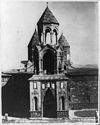
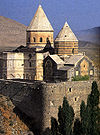
Nagorno-Karabakh
Republic (Artsakh)Amaras · Bovurkhanavank · Dadivank · Gandzasar · Gtichavank · Tsitsernavank · Yeghishe Arakyal · Yerits Mankants Azerbaijan Saint Sargis Monastery of Gag · Targmanchats · Nakhichevan: Julfa cemetery List of Armenian churches in Nakhchivan Georgia (country) Holy Mother of God (Mens) · Norashen · Bethlehem St. Astvatsatsin · Armenian Cathedral of Tbilisi · Vera St. Cross · Krtsanis Tsiranavor Surb Astvatsatsin (Geghardavank) · Jigrasheni Avetyats church · Dzorabash St. Gevorg · Zrkinyants St. Gevorg · Kamoyants St. Gevorg · Kuky St. Astvatsatin · Mughni St. Gevorg · Navtlukh St. Gevorg · St. Gevorg · St. Grigor Lusavorich · St. Karapet · St. Minas · Tandoyants St. Astvatsatsin · Hreshtakapetats · Chugureti St. Astvatsatsin Iran Dzor Dzor · Holy Mother of God · Saint Stepanos · Saint Thaddeus New Julfa: Church of Bethlehem · Holy Mother of God · Saint Catherine · Saint Gregory · Saint Minas · Saint Nicholas · Saint Sarkis · Saint Stepanos · Vank Cathedral Israel Cathedral of St. James · Church of the Archangels · St. Toros Church · Chapel of Saint Helena · Saint Nicholas Monastery Turkey Aghtamar · Aprank · Arter · Cathedral of Arapgir · Bagnair Monastery · Banak · Gagikashen · Holy Apostles Church of Kars · Holy Apostles Monastery · Holy Mother of God Cathedral of Ani · Horomos · Karmravank · Khtzkonk · Ktuts · Kümbet Kilise · Lim · Monastery of the All-Saviour (Trebizond) · Mren · Diyarbakir · Narekavank · Saint Bartholomew Monastery · Saint George of Samatya, Istanbul · Saint Hakob of Akori Monastery · Saint Hovannou Monastery · Saint Karapet Monastery · Saint Krikor Monastery · Saint Mary's Monastery of Karmravor · Soradir · St. Marineh Church, Mush · Tekor Basilica · Varagavank · Varzahan Monastery Ukraine Cathedral of the Assumption of the Blessed Virgin Mary · Surb Khach Monastery  Armenia PortalCategories:
Armenia PortalCategories:- Armenian cemeteries
- Cemeteries in Armenia
- Christian Orthodox cemeteries
- Visitor attractions in Armenia
- 10th century in Armenia
Wikimedia Foundation. 2010.

